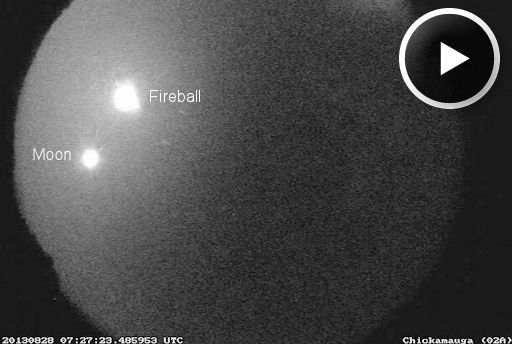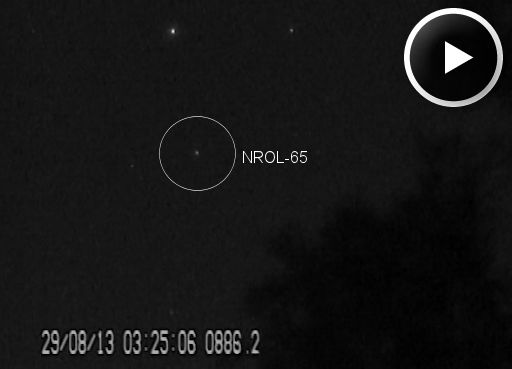Listen to radar echoes from satellites and meteors, live on listener-supported Space Weather Radio. | | |
WEEKEND AURORA WATCH: NOAA forecasters estimate a 60% chance of polar geomagnetic storms this weekend when a solar wind stream is expected to hit Earth's magnetic field. High-latitude sky watchers, especially those located around the darkening Arctic Circle, should be alert for auroras. Solar flare alerts: text, voice.
MAJOR FIREBALL EVENT, UPGRADED (AGAIN): NASA's Meteoroid Environment Office has upgraded its estimates of a major fireball that exploded over the southeastern USA around 2:30 AM on August 28th. Lead researcher Bill Cooke says "the fireball reached a peak apparent magnitude of -16, about 20 times brighter than a Full Moon, and cast shadows on the ground. This indicates that the meteoroid had a mass of more than 110 kg (240 lbs) and was up to a meter in diameter. It hit the top of Earth's atmosphere traveling 25 km/s (56,000 mph)." Watch the movie, then read more about the fireball below:

"This is the brightest event our network has observed in 5 years of operation," he continues. "There are reports of sonic booms reaching the ground, and data from 4 doppler radars indicate that some meteorites may have fallen along the fireball's ground track." (Note: The city in the ground track map is Cleveland, Tennessee, not Cleveland, Ohio.)
An initial calculation of the fireball's orbit suggested it might be a fragment from a Jupiter family comet. Improved estimates of the orbital parameters point to a different kind of object: a main belt asteroid. If meteorites are recovered from the Tennessee countryside, their chemical composition will tell researchers more about the origin of the fireball.
Realtime Meteor Photo Gallery
SPY SATELLITE SPOTTED: On Wednesday, Aug. 28th, a Delta IV Heavy rocket (the world's largest, according to the United Launch Alliance) blasted off from Vandenberg Air Force Base in California. Its secret payload was classified by the US National Reconnaisance Office. So much for secrets. Amateur sky watchers are already tracking the NROL-65 satellite as it circles Earth. Kevin Fetter video-recorded the spysat last night as it glided silently over his back yard in Brockville, Ontario, Canada:

"In the video," says Fetter, "the satellite flew right by kappa Ophiuchus." That star is variable with a magnitude ranging between +4 and +5. Judging from the video, the satellite is about as bright as kappa Oph, say +4.5. This means it is faint but visible to the human eye from dark-sky sites.
No one outside classified circles knows exactly what this satellite does. Speculation is centering on the possibility that it is a KeyHole intelligence satellite of KH-11 lineage. Keyhole satellites are a bit like the Hubble Space Telescope, except pointed at Earth instead of the heavens. NROL-65 could be going up to replace a similar satellite, USA 186 (05042A / 28888), launched from Vendenberg in October 2005.
Would you like to see NROL-65 for yourself? Download this app to turn your smartphone into a spysat tracker. Our Simple Flybys web tool is also tracking NROL-65. If it is looking at you, you might as well look back.
SPACE WEATHER RADIO UPDATE: As a result of indiscriminate "sequester" budget cuts, the USAF Space Surveillance Radar will be shut down at the end of September. Readers have asked what this means for Space Weather Radio. For years we have broadcast Space Surveillance Radar echoes from meteors passing over the facility. Anticipating the shutdown, our radio engineer Stan Nelson is changing frequencies. "I have erected a new 50 MHz 4-element beam antenna for the Digital TV carrier of 54.310 MHz and have it feeding the receiver at SpaceWeatherRadio.com," he explains. The echoes we hear now will be TV signals bouncing off the ionized trails of meteors. "I will be experimenting with the direction and signal strength over the next couple of days, so stay tuned."
Realtime Space Weather Photo Gallery
Realtime Aurora Photo Gallery
Realtime Noctilucent Cloud Photo Gallery
[previous years: 2003, 2004, 2005, 2006, 2007, 2008, 2009, 2011]
Realtime Comet Photo Gallery

